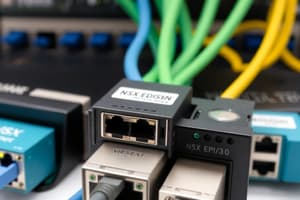Podcast
Questions and Answers
What needs to be verified for the storage configuration of NSX Edge VMs?
What needs to be verified for the storage configuration of NSX Edge VMs?
- The version compatibility of virtualization software
- The total number of virtual machines hosted on the local server
- The accessibility and configuration of datastores (correct)
- The network speed and latency to external systems
Which factor is crucial for ensuring proper network connectivity in an NSX Edge cluster?
Which factor is crucial for ensuring proper network connectivity in an NSX Edge cluster?
- The bandwidth of the external system connections
- The routing and connectivity between all components (correct)
- The type of Edge VMs used in the deployment
- The number of vCenter Servers deployed
What should be done to ensure the compatibility of components with vSphere 5.2?
What should be done to ensure the compatibility of components with vSphere 5.2?
- Enforce a uniform naming convention for all hosts
- Update all components to the latest firmware
- Consult the specialized NSX user forums
- Verify there are no known compatibility issues (correct)
What is a known limitation of vSphere 5.2?
What is a known limitation of vSphere 5.2?
What should be configured on vSphere hosts and edge VMs for effective NSX functionality?
What should be configured on vSphere hosts and edge VMs for effective NSX functionality?
What should be recorded when tracking known issues of vSphere 5.2?
What should be recorded when tracking known issues of vSphere 5.2?
What should be assessed to ensure proposed use cases can be met in vSphere 5.2?
What should be assessed to ensure proposed use cases can be met in vSphere 5.2?
What is essential for planning an upgrade from vSphere 5.2?
What is essential for planning an upgrade from vSphere 5.2?
What should be tested regarding the configured firewall rules for NSX?
What should be tested regarding the configured firewall rules for NSX?
What aspect of network connectivity should be validated for NSX Edge clusters?
What aspect of network connectivity should be validated for NSX Edge clusters?
What is required for vSphere networking in an NSX Edge Cluster deployment?
What is required for vSphere networking in an NSX Edge Cluster deployment?
Which of the following statements about vCenter Server requirements is true?
Which of the following statements about vCenter Server requirements is true?
What must be ensured regarding the NSX Manager in the deployment process?
What must be ensured regarding the NSX Manager in the deployment process?
Which security measures must be implemented for NSX Edge cluster deployment?
Which security measures must be implemented for NSX Edge cluster deployment?
What is an essential requirement for VMware Tools in hosted NSX Edge VMs?
What is an essential requirement for VMware Tools in hosted NSX Edge VMs?
What must be validated regarding NSX Edge VMs placement?
What must be validated regarding NSX Edge VMs placement?
Which of these is NOT a requirement for hosts in an NSX Edge cluster deployment?
Which of these is NOT a requirement for hosts in an NSX Edge cluster deployment?
What is a prerequisite for establishing a vSphere transport zone?
What is a prerequisite for establishing a vSphere transport zone?
What licensing requirement is necessary for the NSX Edge cluster?
What licensing requirement is necessary for the NSX Edge cluster?
In terms of resources, what must be evaluated for vSphere hosts when deploying NSX Edge VMs?
In terms of resources, what must be evaluated for vSphere hosts when deploying NSX Edge VMs?
What network configuration is essential for connectivity in the NSX Edge deployment?
What network configuration is essential for connectivity in the NSX Edge deployment?
What must be taken into account to ensure sufficient performance of the NSX Edge?
What must be taken into account to ensure sufficient performance of the NSX Edge?
Which aspect of NSX Edge deployment requires careful planning to accommodate future needs?
Which aspect of NSX Edge deployment requires careful planning to accommodate future needs?
What must be ensured to protect the NSX Edge cluster from vulnerabilities?
What must be ensured to protect the NSX Edge cluster from vulnerabilities?
Which requirement must be met regarding third-party plugins during the NSX Edge deployment?
Which requirement must be met regarding third-party plugins during the NSX Edge deployment?
What is necessary to understand for effective configuration and deployment of the NSX Edge cluster?
What is necessary to understand for effective configuration and deployment of the NSX Edge cluster?
Which security consideration is crucial for the NSX Edge cluster?
Which security consideration is crucial for the NSX Edge cluster?
What element is essential for all VMware Tools in the context of NSX Edge VMs?
What element is essential for all VMware Tools in the context of NSX Edge VMs?
What must be assessed to maintain the manageability and performance of network zones in NSX Edge?
What must be assessed to maintain the manageability and performance of network zones in NSX Edge?
What is essential for ensuring the effective communication of the NSX Edge cluster with other network components?
What is essential for ensuring the effective communication of the NSX Edge cluster with other network components?
What is a necessary prerequisite for managing an NSX Edge cluster?
What is a necessary prerequisite for managing an NSX Edge cluster?
Which component is necessary for the network configuration of an NSX Edge cluster?
Which component is necessary for the network configuration of an NSX Edge cluster?
What aspect of storage must be verified before deploying an NSX Edge cluster?
What aspect of storage must be verified before deploying an NSX Edge cluster?
Which of the following is NOT required for the deployment of NSX Edge?
Which of the following is NOT required for the deployment of NSX Edge?
Which statement is true regarding the hardware prerequisites for NSX Edge cluster deployment?
Which statement is true regarding the hardware prerequisites for NSX Edge cluster deployment?
What role do NSX Edge configuration files play in the deployment process?
What role do NSX Edge configuration files play in the deployment process?
Why is appropriate vCenter Server licensing crucial for NSX Edge clusters?
Why is appropriate vCenter Server licensing crucial for NSX Edge clusters?
What are the consequences of insufficient network connectivity during NSX Edge operations?
What are the consequences of insufficient network connectivity during NSX Edge operations?
What administrative aspect is vital for managing NSX Edge effectively?
What administrative aspect is vital for managing NSX Edge effectively?
What should be ensured regarding the ESXi hosts for NSX Edge deployment?
What should be ensured regarding the ESXi hosts for NSX Edge deployment?
Flashcards
Storage Configuration
Storage Configuration
Ensuring enough storage space is available for NSX Edge VMs and related components, verifying datastores are properly configured and accessible.
Firewall Rules
Firewall Rules
Setting up rules on vSphere hosts and Edge VMs to allow necessary communication for NSX Edge functionality. Ensure the right rules are in place for communication between different parts of the deployment.
Network Connectivity
Network Connectivity
Verifying smooth network communication between all components of the NSX Edge cluster, including vCenter Server, Edge VMs, transport zones, and external systems. Ensure proper routing through network paths.
Compatibility
Compatibility
Signup and view all the flashcards
Known Issues in vSphere 5.2
Known Issues in vSphere 5.2
Signup and view all the flashcards
Limited Features in vSphere 5.2
Limited Features in vSphere 5.2
Signup and view all the flashcards
Upgrade Planning
Upgrade Planning
Signup and view all the flashcards
Why is storage configuration important for NSX Edge VMs?
Why is storage configuration important for NSX Edge VMs?
Signup and view all the flashcards
What are the key components of NSX Edge communication that need firewall rules?
What are the key components of NSX Edge communication that need firewall rules?
Signup and view all the flashcards
vCenter Server Requirement
vCenter Server Requirement
Signup and view all the flashcards
vSphere Networking
vSphere Networking
Signup and view all the flashcards
Host Requirements
Host Requirements
Signup and view all the flashcards
NSX Manager
NSX Manager
Signup and view all the flashcards
Security Measures
Security Measures
Signup and view all the flashcards
VMware Tools
VMware Tools
Signup and view all the flashcards
NSX Transport Zone
NSX Transport Zone
Signup and view all the flashcards
Licensing
Licensing
Signup and view all the flashcards
NSX Edge VM Placement
NSX Edge VM Placement
Signup and view all the flashcards
NSX Edge Cluster Deployment
NSX Edge Cluster Deployment
Signup and view all the flashcards
What are the networking requirements for NSX Edge?
What are the networking requirements for NSX Edge?
Signup and view all the flashcards
What are the compute resource requirements for NSX Edge?
What are the compute resource requirements for NSX Edge?
Signup and view all the flashcards
Why are security considerations important for NSX Edge?
Why are security considerations important for NSX Edge?
Signup and view all the flashcards
What is network segmentation?
What is network segmentation?
Signup and view all the flashcards
What are network performance requirements for NSX Edge?
What are network performance requirements for NSX Edge?
Signup and view all the flashcards
What are VMware Tools?
What are VMware Tools?
Signup and view all the flashcards
Why is understanding NSX Edge functionality crucial?
Why is understanding NSX Edge functionality crucial?
Signup and view all the flashcards
What are third-party plugins?
What are third-party plugins?
Signup and view all the flashcards
Why is planned capacity important for NSX Edge?
Why is planned capacity important for NSX Edge?
Signup and view all the flashcards
What is the main benefit of network segmentation?
What is the main benefit of network segmentation?
Signup and view all the flashcards
What is the role of vCenter Server in NSX Edge deployment?
What is the role of vCenter Server in NSX Edge deployment?
Signup and view all the flashcards
Why are ESXi hosts important for NSX Edge?
Why are ESXi hosts important for NSX Edge?
Signup and view all the flashcards
What is a DVS?
What is a DVS?
Signup and view all the flashcards
What are NSX Edge configuration files?
What are NSX Edge configuration files?
Signup and view all the flashcards
Why is storage critical for NSX Edge?
Why is storage critical for NSX Edge?
Signup and view all the flashcards
Hardware Capabilities
Hardware Capabilities
Signup and view all the flashcards
Admin Permissions
Admin Permissions
Signup and view all the flashcards
Why is it important to consider potential compatibility issues?
Why is it important to consider potential compatibility issues?
Signup and view all the flashcards
Study Notes
Prerequisites for NSX Edge Cluster Deployment in vSphere 5.2
- A vCenter Server Appliance (vCSA) 5.2 or higher is required; proper configuration and accessibility are essential.
- A vCenter Server 5.2 instance manages the NSX Edge cluster, and the underlying ESXi hosts; at least two ESXi hosts are needed, configured for proper NSX Edge component placement and essential storage resources (VMFS datastores or virtual disks).
- Well-defined vSphere networking, including Virtual Distributed Switches (vDS), is crucial; appropriate configuration and accessibility for the NSX Edge cluster are needed. Verify network segmentation and IP addressing. A configured DVS for the vCenter cluster is required for the deployment.
- Hosts must be part of the vCenter Server inventory, have adequate CPU, memory, and storage capacity, and communicate properly; vSphere HA and DRS should be enabled. Evaluate host resources to support Edge VMs, considering potential resource contention. Hosts must meet vCenter 5.2 requirements (CPU, memory, disk space).
- NSX Manager must be deployed and configured; thorough functionality testing is needed. Check storage and CPU/memory on the NSX Manager VM. Files for management templates are required and must be prepared before deployment.
- Essential security measures, including necessary vCenter and NSX privileges (especially network configuration and management) are required. Policies and permissions must align with security protocols.
- Hosted NSX Edge VMs need VMware Tools installed, properly configured, and functioning. Validate VMware Tools version compatibility with the ESXi host. Test tools installation and proper operation on sample VMs.
- A vSphere transport zone is needed for NSX Edge network processing and routing; it serves as a shared resource. Ensure consistent network connectivity among all hosts in the transport zone.
- Appropriate VMware NSX licensing must be purchased and applied. Validate licensing and functionality with suitable test data.
- Determine the optimal location and distribution of NSX Edge VMs across vSphere hosts; consider network latency, geographic dispersion, and resource contention. Locations must handle estimated load, and sufficient bandwidth/connectivity between hosts must be confirmed.
- Sufficient storage capacity on datastores for Edge VMs is required; consider storage capacity and redundancy for NSX components. Verify datastores are properly configured and accessible.
- Firewall rules should be configured on vSphere hosts and Edge VMs to allow NSX Edge component traffic; ensure correct rules for communication. Test configured rules and network connectivity.
- Validate network connectivity between all components (vCenter, Edge VMs, transport zones, external systems). Validate routing and network interactions with other resources. Correct networking configurations are essential for the NSX Edge cluster.
- Ensure adequate storage space on underlying datastores for NSX Edge VMs.
- Network components must be correctly configured, allowing external communication and interaction of other network resources. Configure routers and firewalls with policies for NSX Edge.
- Ensure adequate computing resources (memory, processor speed) for vSphere VMs and NSX Edge services. Necessary resources are needed for handling expected demands.
- Adequate security measures (firewalls, ACLs) must protect the NSX Edge cluster. Ensure security procedures mitigate potential risks to the network environment.
- Network segmentation configurations are required to isolate network zones for security and manageability.
- Adequate network bandwidth and latency are essential for NSX Edge performance.
- VMware Tools compatibility with both the vCenter version and ESXi hosts' OS is required.
- A complete understanding of the NSX Edge cluster's functions is necessary for proper deployment.
- Examine compatibility with any third-party plugins.
- Plan capacity requirements for cluster growth and future scaling.
- Appropriate licensing for NSX and underlying vSphere 5.2 platform resources (especially for VMs) is required. Licensing must cover necessary features for the NSX Edge and its components.
Specific Considerations for vSphere 5.2
- Ensure all components (hosts, vCenter, NSX) are fully compatible with vSphere 5.2. Verify compatibility issues are avoided.
- Consult VMware documentation for known vSphere 5.2 issues. Document and address resolved issues.
- Be aware of vSphere 5.2's limited features compared to later versions; understand feature gaps and develop alternative strategies.
- If planning a future upgrade, document the current configuration and plan for maintaining functionality during the transition.
Studying That Suits You
Use AI to generate personalized quizzes and flashcards to suit your learning preferences.
Description
Test your knowledge on the prerequisites for deploying an NSX Edge cluster in vSphere 5.2. This quiz covers the essential requirements related to vCenter Server, vSphere networking, hosts, and the NSX Manager. Answer questions to ensure you understand the configuration needed for a successful deployment.



